
The Mulch
Saving Our Seeds
One of the delights of the autumn garden for me is to collect seeds from drying, spent flowerheads on warm, calm, sunny days. This year I had a bumper seed-producing season, aided by lots of lovely days to go out collecting!
Hundreds of Californian Poppy seedpods (Eschscholzia californica – Monarch mixed) twisted and cracked open with noisy abandon from August onwards, releasing thousands of tiny round seeds. I’m sure I only managed to collect a tiny fraction of them.
The Marigolds (Calendula officinale) also did stirling work this year producing beautiful bright flowers from mid summer onwards – and are flowering even now as I type this, at the end of November. Their seeds look like tiny, ornately nailed harp frames!
With seeds, though, collecting them tends to be the easy part. Getting them to survive storage, to germinate or to select for desirable qualities of vigour and fertility are another matter. For an easy to follow guide on what to do with seeds you’ve collected from your vegetable and fruit patch herb beds or shrub borders, visit:
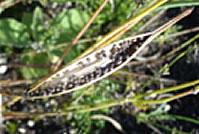 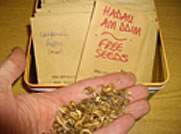 < Twist ‘n Shake < Twist ‘n Shake
A Californian Poppy seedpod has twisted open to reveal two neat rows of seeds
Getting Smashed at Christmas…
Back in September, permaculturalists and neighbours, Kim and Martin, gave me some spare chitted Edgecote Purple and Duke of York potatoes. Kim had read about an experiment to plant them in autumn for a table-ready crop at Christmas.
Needing approximately 16 weeks, I was cutting it a bit fine to be able to achieve this goal as, at my elevation of 600ft, it’s much windier, cloudier and a degree or two cooler than on the sheltered Menai Straits where Kim and Martin live.
Nevertheless, through October and most of November, enjoying the unusually mild weather even here, the potato vines have grown way beyond the special growing bags I had planted them in. Having endured some very windy weather at times, I then moved them into my unheated greenhouse during the middle of November.
The lower light levels have checked growth considerably, but apart from some slug damage on younger top growth, I think I may well be on course to be melting butter over tasty tubers this festive season!
I’ll report back in the spring on the outcome of this horticultural experiment.
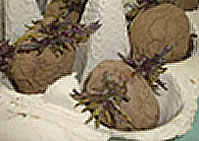 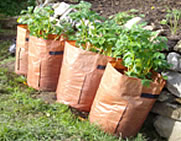 < Purple Patch < Purple Patch
Four bags of late-chitted potatoes enjoying the autumn sunshine
Nordic Cool…
A back garden close to the city centre in Winchester has been transformed this summer into a courtyard with a distinctly Scandinavian flavour.
My clients have strong connections with Denmark and wanted something of the country’s garden traditions to be included in the design of the space.
We turned the layout through 45 degrees to create a dynamic and interesting pattern in the 7m x 7m garden area. Two lines of double row granite setts then form an offset cross, infilled with dark limestone. This calming colour combination is balanced with the addition of cedar clad raised beds, echoing the materials used for the gymnasium at the end of the garden.
And by working closely with the building architect at the design stage, we were able to strongly connect the new gym to the garden by adding a projecting ‘beak’ in the front glass wall.
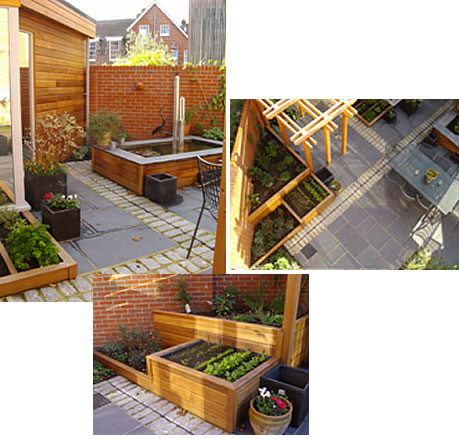
^ Dane Gold
The paving pattern is interlaced with a cross made up of double rows of silver granite setts. Cedar clad raised beds create a warm counterbalance to the limestone and granite
Planting was kept to a fairly narrow palette of greens (mainly evergreens for year-round structure) but with counterpointing splashes of red, yellow and pink, to echo the Scandinavian tradition of the informal and joyful ‘Grandmother’s Garden’ style.
This garden style emphasises the ephemeral nature of a northern summer – bright, vibrant primary colours from herbaceous perennials and annuals leap out from low growing shrubs all summer long, lightening the greyest of days.
Variegated leaves lighten the planting pockets in the darker corners of this east-facing courtyard and there are lots of climbers (Wisteria, Clematis and Roses) to increase a sense of privacy and withdrawal.
An extra dimension to the garden is that it can be viewed from an atrium style window, three floors up. From this vantage point it’s possible to make out the cross shape in the Danish flag echoed in the paving pattern below.
Welsh to the Core…
One of my local gardening clients here in North Wales has a small apple tree that had a really pretty crop of large-ish apples on it this autumn. I didn’t recognise the type – larger than the Duchess of Oldenburg and pinker than Gala; it turned out to be one of the locally famous Bardsey Island Apple trees.
I had heard of this fabled tree but never seen one in fruit. Some have dismissed it as a marketing ploy but a search on the internet attests to the discovery of this apple by Ian Sturrock and Sons, a Bangor-based fruit tree nursery and plant specialist, back in 1998.
The original (and sole-surviving) tree was believed to be a remnant of a thriving monastic orchard on Bardsey dating from the Middle Ages and was discovered quite by chance growing hard against the protective wall of Plas Bach, one of the island’s houses. It was also found to be in a completely disease-free state.
As well as the Bardsey Island Apple, Ian Sturrock & Sons also stock other rare Welsh fruit trees including the Snowdon Queen Pear, Abergwyngregyn Damson, and the Welsh Cox Apple. More details at:
www.iansturrockandsons.co.uk
www.bardseyapple.co.uk
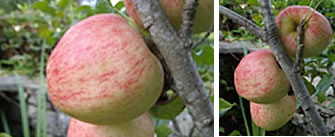 < Keeping the Doctor Away – pt 1 < Keeping the Doctor Away – pt 1
The Bardsey Island Apple is boldly striped pink over cream, with a subtle scent of lemon.
Fine and Dandy
The much maligned Dandelion (Taraxacum Officinale) gets a bad press from the lawn-lovers and vegetable growers among us but did you know that it is a whole medicine chest in a single plant for herbalists and naturopaths?
All parts of the plant can be used. Its leaves contain high amounts of Vitamins A, B complex and C, and calcium, phosphorus and iron. The root is also good for you, but is stronger in taste and effect than the leaves.
The flower is tasty in tea. Just bear in mind to take medical advice before preparing any concoctions, meals, teas or medicines from herbs and don’t use any where there has been pesticide and herbicide spraying!
Here are a few ideas on how you can use this ubiquitous plant in the kitchen and medicine chest, taken from www.gardenerspath.com:
Dandelion Oil – collect a jar full of healthy flowers and cover with almond or grapeseed oil. Float a small amount of vodka on top to prevent mould forming. Keep in a warm place for about 4 weeks.
Coffee Substitute – late summer roots best. Clean and roast for 2 hrs at 200C/Gas 6, grind as per coffee.
Dandelion Tincture – 2 cups of roots, clean and slice thinly. Cover in a jar with vodka. Ready in about 8 weeks. Use a couple of drops with water.
Dandelion Vinegar – use flowers and leaves. Chop together, place in a jar and cover with cider vinegar.
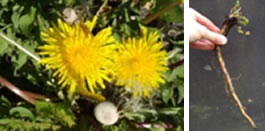 <Keeping the Doctor Away – pt 2 <Keeping the Doctor Away – pt 2
Originally from Greece, the Dandelion’s name translates loosely as ‘medicine to remedy disorders’.
Cuttings…
Stalking Club Root
Reading through a few back issues of Smallholder news from 1962 recently, I read about an effective preventative measure against Brassica club root – slice up rhubarb stalks into inch long lengths and place one in the bottom of each hole before planting out your cabbage and cauliflower plants.
The Bees Knees
Congratulations to the Bumblebee Conservation Trust (BBCT) for the grant awarded by the Heritage Lottery Fund for their ‘Bees for Everyone’ project. Over the next three years, the BBCT aims to safeguard and promote flower-rich habitats and to raise public awareness of the plight of rare bumblebees throughout the UK. You can help them at:
www.bumblebeeconservation.org
The Only Way Is Up…
Milan-based architecture firm, Stefano Boeri Architetti, hopes to merge vegetation and urban architecture, with its Bosco Verticale (Vertical Forest) project. Two residential towers are planned for construction. The towers, measuring 110 and 76 meters (361 and 250 feet), will become home to over 900 trees and a wide range of shrubs and floral plants. www.gizmag.com/bosco-verticale-vertical-forest/20194/
Shedding Light…
The recently published British Crime Survey reports a worrying increase in incidents outside the home. Theft from sheds and gardens increased more than any other crime, up by 13% on the previous year. www.homeoffice.gov.uk
Living the High Life…
This summer I tackled the roof of the pigsty. For months, flimsy corrugated iron sheets had battled the wind and rain while I decided what to do.
Clearing the garden of sedum and geranium, I came up with the idea of using the material again as the roof covering on a living roof. These plants seem to survive here on very little soil and this artifical growing space would just be another home from home.
I used OSB for the sarking board layer, fixed to 4” treated posts with underlay, DPM and a cardboard layer under a thin layer of soil and compost. I then planted sedum and geranium around the edges and sowed grass seed in the central area. I have created a ‘How-to’ instruction sheet for a living / green roof at: www.thegrowingcompany.co.uk/
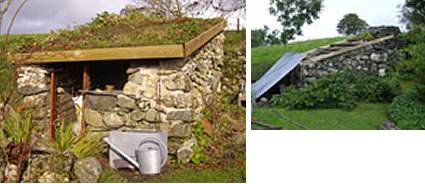
< The pigsty before work began
< A Grassy High
The new pigsty roof blends in nicely with its surroundings – and keeps my logs stored there dry
Mark Rendell
gardener and garden designer
____________________________________________________________
Imaginative and affordable design
and planting schemes for every kind of garden
www.thegrowingcompany.co.uk
t: 01766 530824 m: 07780 920653
|

